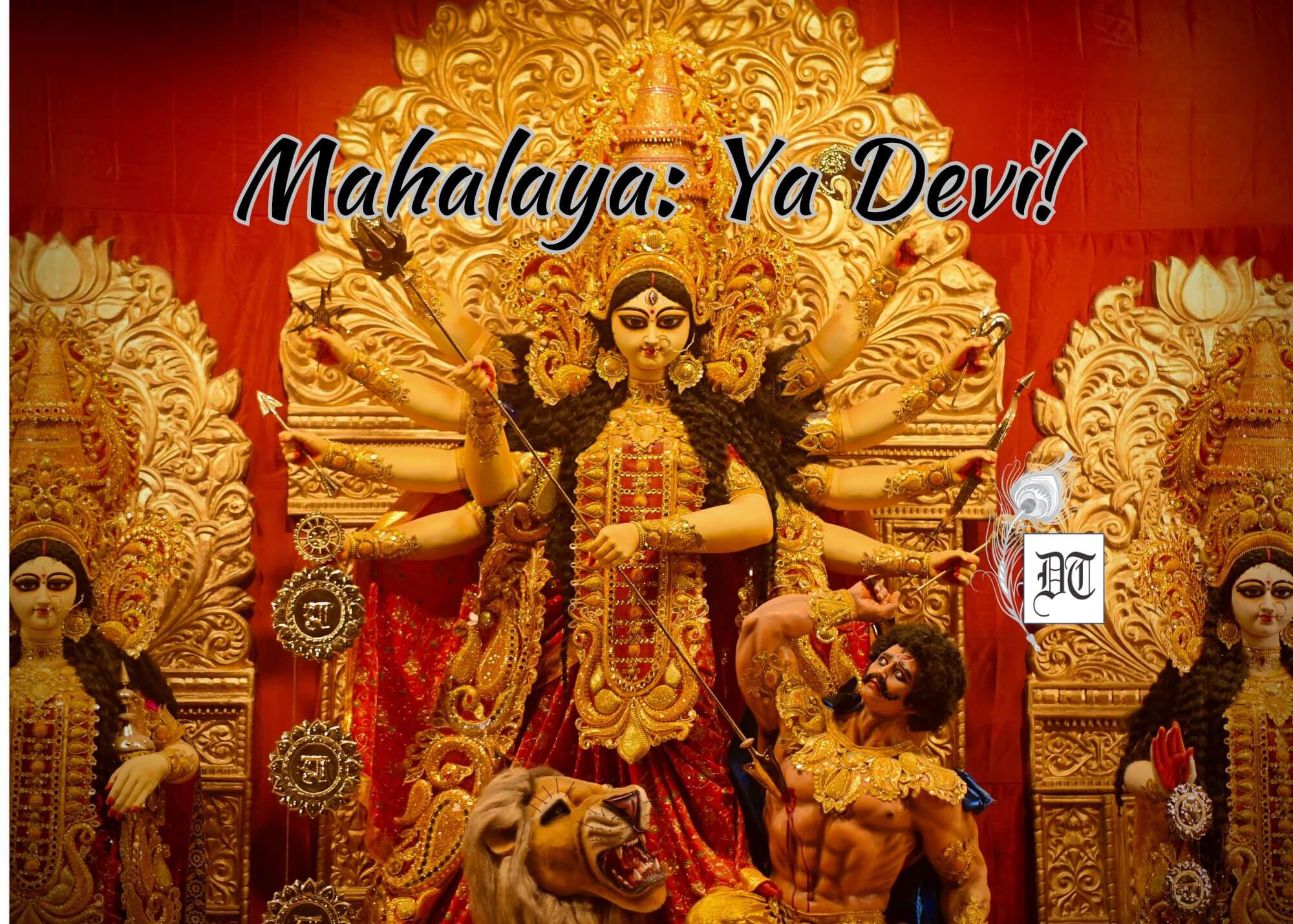In the curtain raiser on Durga Puja special feature, Arindam traces the genesis of the global celebrations of the Shakti puja. Shakti or Energy, is invoked during both the equinoxes. Durga is worshipped twice, during Basant or Vasant and Sharad, the Spring and the Autumn. The feminine principle, the life-giver, portrayed as Prakriti. Not to speak of the mortals, even the gods and demons are powerless without Shakti, the Energy. Medical science tells us that diseases become active during the change of seasons. Disease and death belong to the world of the Dark. These are evil forces, symbolised by the powerful demon, the Mahisasur. Durga slays the demon. She gives us the power (read immunity) to demolish and destroy the diseases.
Durga Puja – pronounced ‘Pujo’ by a section of Bengalis, the Ghotis, those with their origins in West Bengal – Navaratri (in North and West India), Navarathri (in South India) and Dussehra (in various parts of India) may be broadly classified as the Autumnal Festivals of India. It’s a pan-Indian carnival.
We, in Different Truths (DT), extend our Sharodiya (Autumnal) Greetings to all our readers, authors (columnists, writers, and poets), our Editorial Board, and friends, the world over.
Our sages and seers advised the believers that the turning points of days and seasons are of great relevance. It’s a time of meditation and prayers. The two twilights, dawn and dusk, and the two equinoxes, Spring and Autumn, are of great relevance. The wise men and women of Hindu religion explained these as contestations and conflicts between the good (devas, surs) and the evil (rakshasa, asurs). Light has been exemplified as vidya (learning, knowledge, wisdom, emancipation, etc), which is in conflict with the forces of the Dark that symbolises avidya (ignorance, vanity, ego, delusions, etc). We see these visible during dawn and dusk, which is the presence of the two, light and darkness (twilight). It’s, therefore, a time of deep contemplation, of meditation and prayer.
Interestingly, Shakti or Energy is invoked during both the equinoxes. Durga is worshipped twice, during Basant or Vasant and Sharad, the Spring and the Autumn. The feminine principle, the life-giver, portrayed as Prakriti. Not to speak of the mortals, even the gods and demons are powerless without Shakti, the Energy.
The Tantric symbolism comes to mind. Shiva, the Almighty, is a mere shava (corpse). Only when Shakti touches him, as Kali, with her foot on His chest, does he get the eekar from the Goddess, and is transformed into Shiva.
Medical science tells us that diseases become active during the change of seasons. Disease and death belong to the world of the Dark. These are evil forces, symbolised by the powerful demon, the Mahisasur. Durga slays the demon. She gives us the power (read immunity) to demolish and destroy the diseases.
The Puranas tell us that the worship of the Goddess during the Autumn is Akaal Bodhan (invoking and awakening Her from a deep slumber at a wrong time). It’s known as the Shakti Puja of Lord Rama. The Durga Puja at this time of the year by Bengalis is the legacy of Lord Rama’s Shakti Puja.
We, in DT, reiterate our pledge with the forces of the Good – that of Love and Light. We believe in the essential goodness of human beings and have thus created a platform to network the Positive Forces, globally.
In this era of violence, of gun culture, of terrorism and war, we need to create a global force to counter the forces of avidya. We will feature DT’s Durga Puja special issue for three consecutive days, Friday to Sunday (Oct 7 to 9). All our regular columns, except the Cover Story, shall remain suspended during this period.
Champa Srinivasan reminisces about the Puja shopping that begins with the Vishwakarma Puja, in her article, Children and Durga Puja: The Joys of Puja Shopping.
Souma Kanti Roy turns his gaze to the Puja preparations in present day Kolkata, in his article, The Fever and Frenzy of Puja Grips Kolkata with Renewed Vigour.
Anumita Chatterjee Roy’s article, Bangaliyana: A Search and Assertion of the Bengali Identity on Foreign Lands, tells us that Durga Puja is the time when Bengalis all over the world return to their roots. This rootedness is the Bengalis’ need for asserting their identity. The void of leaving one’s home and hearth is often filled by the need to stay connected and rooted in one’s essential tradition.
Rajini Shankar dwells on the celebrations of the Autumnal festival in various parts of India, with special reference to the two southern states, Tamil Nadu and Karnataka, in her article, Pan-India Navaratri Celebrations with Special Reference to South India.
Champa Srinivasan, a Bengali married to a Tambram, takes us into the world of the celebrations in Tamil Nadu, in her interesting write-up, Navarathri Celebrations in Tamil Nadu.
The article, I met Goddess Durga as an Army Wife in Bengal and the Gorkha Regiment, is based on the reminiscences of Lily Swarn. She and her husband were posted at various parts of the country.
Aseem Asha Usman tells us how he inspired one of his students to highlight the sufferings and exploitation of women through the story of Durga, depicted in paintings, to empower the women. The article, Durga Redefined: A Muslim Girl Inspired by Durga Paints the Goddess, is the faith in the Indian sensibility. It breaks the shackles of dos and don’t of a Muslim. The emancipation operates at many levels.
Two short stories need special mention. These dwell on the symbolism of Durga. Adrija, by Sudeshna Mukherjee, and Padmavati: A Hurricane of the Heaven, by Subhajit Sanyal, enrich the theme.
Our Fashionista, Neeti Banga, talks about the Durga Puja fashion of Bengalis and Gujaratis during Navaratri Garba and Dandia, in her article, This Durga Puja be the Goddess you are!
In the humour piece, When Hanuman Cussed and Rama Smoked Bidi, Arindam Roy recalls two incidents from the Ramlila. Facts are stranger than fiction!
Durga Puja ends with sweets. The last article, by Sonali Chakraborty, Celebrate Durga Puja with the Delicious Bengali Sweet Roshomalai, promises greater celebrations next year.
Last but not the least, we feature eight poems by seven poets.
We hope and trust that you will enjoy the Durga Puja celebrations on DT.
We wish a Happy and Prosperous Durga Puja, Navaratri and Dussehra to one and all.
©Arindam Roy
Pix from Net.









Edition from 3 years back is as alive and valid-these are timeless writings on such relevant days of the year that marks seasons, festival, spiritual evolution and time to reflect!!